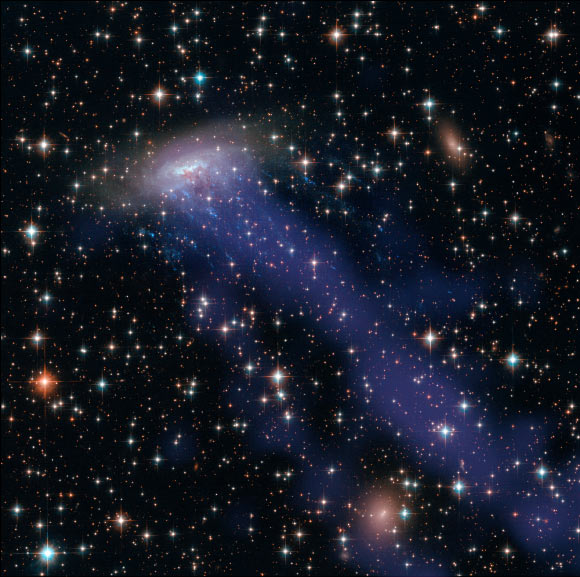Astronomers using NASA’s Hubble Space Telescope and Chandra X-Ray Observatory have captured a stunning new image of the bizarre spiral galaxy ESO 137-001.
ESO 137-001 is located in the southern constellation of Triangulum Australe, in the heart of the galaxy cluster Abell 3627.
This cluster, also known as the Norma Cluster, is a group of galaxies near the center of the Great Attractor, a region of space that earned its name by being so massive. Abell 3627 is violently ripping the spiral’s entrails out into space, leaving bright blue streaks as telltale clues to this cosmic crime.
This region is located around 200 million light-years from our galaxy, the Milky Way. Both our galaxy and its home group, the Local Group, are slowly being hauled towards this mysterious region.
Despite being relatively close by cosmic standards, catching even a glimpse of Abell 3627 is no mean feat. Observed from Earth, the cluster lies close to the plane of the Milky Way and is obscured by a thick smog of cosmic dust.
The new composite image of ESO 137-001, taken with Hubble and Chandra, captures the galaxy in stunning detail and also something more dramatic – intense blue streaks.
These streaks are actually hot young stars, encased in wispy streams of gas that are being torn away from the galaxy by its surroundings as it moves through space. This violent galactic disrobing is due to a process known as ram pressure stripping – a drag force felt by an object moving through a fluid. The fluid in question here is superheated gas, which lurks at the centers of galaxy clusters.
The gas in Abell 3627 is so hot at 180 million degrees Fahrenheit that it glows in X-rays detected by Chandra observatory.
The image also shows other telltale signs of this process, such as the curved appearance of the disc of gas and dust – a result of the forces exerted by the heated gas.
The cluster’s drag may be strong enough to bend ESO 137-001, but in this cosmic tug-of-war the galaxy’s gravitational pull is strong enough to hold on to the majority of its dust – although some brown streaks of dust displaced by the stripping are visible.
Studying ram pressure stripping helps astronomers to better understand the mechanisms that drive the evolution of galaxies. For example, it will leave ESO 137-001 with very little of the cold gas that is essential for star formation, rendering the galaxy effectively incapable of forming new stars.
The new image also tells astronomers a great deal about the harsh environment at the heart of a galaxy cluster, and the fate of galaxies like ESO 137-001 that find passage through it.








